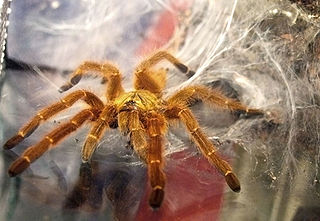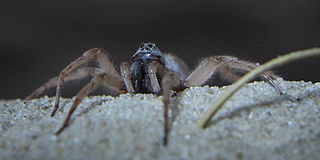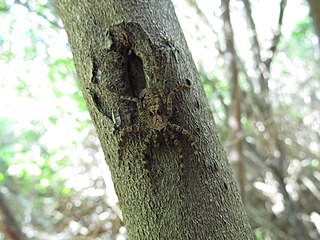
The Harpactirinae are a subfamily of tarantulas which are native to the continent of Africa. Like many Old World tarantulas, they have a relatively strong venom, and can inflict a painful bite.

Hogna is a genus of wolf spiders with more than 200 described species. It is found on all continents except Antarctica.

Moggridgea is a genus of spiders in the tree dwelling family, Migidae. The genus was first described by Octavius Pickard-Cambridge in 1875, who named the genus after naturalist John Traherne Moggridge.

Allocosa is a spider genus of the wolf spider family, Lycosidae. The 130 or more recognized species are spread worldwide.

Idiops is a genus of armored trapdoor spiders that was first described by Josef Anton Maximilian Perty in 1833. It is the type genus of the spurred trapdoor spiders, Idiopidae. Idiops is also the most species-rich genus of the family, and is found at widely separated locations in the Neotropics, Afrotropics, Indomalaya and the Middle East. Females live in tubular burrows lined with a thick layer of white silk. These typically have a D-shaped lid that fits into the entrance like a cork, and some burrows have two entrances. The lid may consist of mud, moss or lichen, which is bound below by a thick layer of silk. As in all genera of this family, the anterior lateral eyes (ALE) are situated near the clypeal margin, far in front of the remaining six eyes, which are arranged in a tight group. The males which are smaller in size, wander about or occasionally live in burrows. Like other mygalomorphs, they are relatively large and long-lived. Forest clearance and agricultural practices that loosen the soil and enhance erosion, besides soil removal for brick making have been pointed out as serious threats to some Indian species. Species ranges are poorly known – in India for instance, most species are known only from their type localities.

Chelypus ('clawfoot') is a genus of slow-moving, burrowing sunspiders confined to the deserts and arid regions of Southern Africa.

Zeria is a genus of solpugid camel spiders, first described by Eugène Simon in 1879.
Ancylotrypa is a genus of African wafer trapdoor spiders that was first described by Eugène Simon in 1889. Originally placed with the Ctenizidae, it was moved to the Cyrtaucheniidae in 1953.

Anyphops is a genus of wall spiders that was first described by P. L. G. Benoit in 1968.
Ceroma is a genus of ceromid camel spiders, first described by Ferdinand Karsch in 1885.
Hemiblossia is a genus of daesiid camel spiders, first described by Karl Kraepelin in 1899.
Biton is a genus of daesiid camel spiders, first described by Ferdinand Karsch in 1880.
Blossia is a genus of daesiid camel spiders, first described by Eugène Simon in 1880.
Hexisopus is a genus of hexisopodid camel spiders, first described by Ferdinand Karsch in 1879.
Solpugema is a genus of solpugid camel spiders, first described by Carl Friedrich Roewer in 1933.
Zeriassa is a genus of solpugid camel spiders, first described by Reginald Innes Pocock in 1897.
Solpugyla is a genus of solpugid camel spiders, first described by Carl Friedrich Roewer in 1933.
Solpuguna is a genus of solpugid camel spiders, first described by Carl Friedrich Roewer in 1933.







